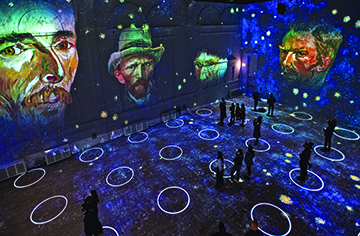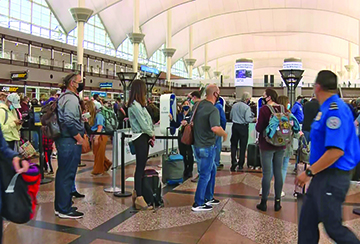
by Mark Smiley | Oct 22, 2021 | Main Articles
by Mark Smiley

Tickets Still Available: Tickets for the exhibit start at $39.99 and are available at www.denvervangogh.com.
The original Immersive Van Gogh exhibit launched on time and without delay on September 30, 2021, in Denver. The immersive exhibit highlights 400 of Van Gogh’s most famous paintings. It is housed at Lighthouse Denver at 3900 Elati Street, located in the former Regency Hotel, just west of the River North Art District (adjacent to I-25).
The Original Immersive Van Gogh Exhibit was designed by Massimiliano Siccardi and opened in Paris, where it attracted 2 million visitors. The exhibit merges video, animation, and other technology to offer something completely different than visiting a traditional art show.
The iconic Regency hotel plays host to this exhibit and provides guests with a new way to experience one of the world’s most iconic post-impressionist artists. “It’s truly a unique piece of art,” said Lighthouse Immersive Producer Corey Ross. “It ties together several things into what I see as a new genre. On one hand you have the art of Van Gogh on display. You also have an animated film. And then we have the experiential element of it. The public gets to walk through and choose their own experience.”
Rising to blockbuster status with over 2 million tickets sold, Immersive Van Gogh is proving to be one of the hottest shows sold-out in Toronto, Chicago, San Francisco, Los Angeles, and New York. With extended runs now available, audiences will have the opportunity to step into this historic space that has been transformed with Van Gogh’s paintbrush in a swirl of color, brought to life with over 90,000,000 pixels of animation spanning over 500,000 cubic feet of projection with 100 projectors.
Emmy Award-winning and Tony Award-nominated designer David Korins, known for his set designs, featured in numerous Broadway hits including Hamilton and Dear Evan Hansen, serves as the Creative Director for the Denver installation. Korins, who also served as Creative Director for the recently opened New York City exhibit, will design unique and experiential elements to transform Lighthouse Denver into a truly one-of-a-kind venue, crafting an experience unique to Denver.

Technological Wonder: The Immersive Van Gogh Exhibit merges video, animation and other technology to offer something completely different than visiting a traditional art show. Photo Credit Michael Brosilow
“We have been delighted to see the way Immersive Van Gogh has been embraced by the city and people of Denver,” said Ross. One of every three residents of Denver has purchased a ticket making it a hot ticket in town.
“We’ve created a unique and enthralling production where Denver residents and visitors alike can quite literally surround themselves with the work of Vincent van Gogh, one of the greatest artists who ever lived,” added Producer Svetlana Dvoretsky.
“We all know that Van Gogh struggled with mental illness,” said Ross. “With depression, with isolation, with loneliness. I think coming out of the pandemic, more than ever, the public can relate to some of what he experienced, particularly the isolation and loneliness. Yet, here we are 130 years after he passed away [he committed suicide at age 37 in 1890], his pieces are known, are still beautiful to us, are colorful and uplifting, and most of all they transcend the difficult experience that he had. That transcendence, to me, is very cathartic to the public.”
Tickets start at $39.99 and the exhibit will run until at least February 6, 2022. For more information about Immersive Van Gogh, visit www.denvervangogh.com.

by Regan Bervar | Oct 22, 2021 | General Featured
“When the going gets weird, the weird turn pro.”
 by Luke Schmaltz
by Luke Schmaltz
Fear and Loathing in Aspen — a forthcoming film set in Colorado’s most notorious mountain town — is packed with parallels to current issues, rich with the warm, grainy texture of 20th Century celluloid, and thick with finely tuned, bittersweet irony.
Unlike predecessors, this film offers a more subtle, nuanced interpretation of the outlandish escapades of the late writer — Hunter S. Thompson. Director Bobby Kennedy III delivers a concise, thoughtful, and well-rounded narrative of Thompson’s 1970 run for Sheriff of Pitkin County, Colorado, on the Freak Power ticket.

Hit Movie: Fear and Loathing in Aspen is a direct hit with many of today’s hot-button issues.
In one scene, Thompson (masterfully played by Jay Bulger) says, “The freaks — they’re everywhere … and they can vote.” He continues his commentary on the local counterculture with more poignant observations, “One of the main things I’ve learned out here is there are all kinds of very capable people wandering around with no place to use their energy. If we can put this energy to work, we’ll have a helluva tool on our hands.”
Throughout the piece, Bulger, who bears an uncanny resemblance to his subject, manages to deliver a convincing portrayal of Thompson while somehow avoiding the character tropes, overblown mannerisms, and hyper-exaggerated speech patterns Thompson’s persona has elicited from those who have portrayed him in the past. Here, viewers are treated to a glimpse into the psyche of a deeply complex character without having to endure the gallivanting around and flailing about of cinematic forebears. Rather, Bulger delves deeper into the humanity of the character, using a somewhat even-keeled anchor point to mount emotional plunges and manic ascents.
Visually, the film pays on-target homage to the wobbly, hand-held 8mm footage that captured many moments of the actual events in the story. Kennedy masterfully rotates between smoothly edited, narrative scenes, and grainy handheld sequences that, were it not for impeccable continuity, could be mistaken for amateur found footage from 1970.
Parallels Abound
Although the story is 50+ years old, the film zaps a cattle prod to a number of today’s hot-button issues. Thompson’s Freak Power party runs the very essence of a grassroots political campaign, echoing current political concerns such as voter reluctance, voter suppression, and election fraud. Meanwhile, the “freaks” of the Aspen Valley — fringe-dwelling refugees of the status-quo — are eerily reminiscent of the drug-addled tent-dwellers of today’s Denver, although in the movie they represent heroism, positive change, and social evolution. And then, there are the conservative gentrifiers who are systematically overtaking Aspen and making Thompson’s proposed utopia an all-but-impossible pipedream. Given the overrun, overdeveloped, and overpriced state of Pitkin County today, it makes you wonder how vastly different that sector of Colorado would look had Thompson been victorious.
A Brazen Platform

Portrayal: Actor Jay Bulger delivers a nuanced, spot-on portrayal of a pop culture legend.
As one would expect, his platform was as sweeping and rebellious as the man’s reputation. “We will sod the streets at once” he begins. “Rip up all city streets with jackhammers and use the junk asphalt, after melting, to create a huge parking and auto storage lot on the outskirts of town. We will change the name of Aspen, by public referendum, to Fat City, to prevent land rapers, greedheads, and human jackals from capitalizing on the name ‘Aspen.’ Aspen, Colorado, would no longer exist, and the psychic alterations of this change would be massive in the world of commerce. By this approach, making hundreds or even thousands of individuals personally responsible for protecting the animals, fish, and birds that live here, we would create a sort of de facto game preserve without the harsh restrictions that will be forced on us if these bloodthirsty geeks keep swarming in here every autumn to shoot everything they see.”
Acerbic, To Wit

In Character: Jay Bulger stays entrenched in character throughout the film.
Alas, the irony that Bobby Kennedy III deals out to viewers is deeply poetic. He skillfully helms a cinematic vehicle that is clearly aimed at the establishment, the status quo, the Good Ol’ Boys Club that his grandfather and great uncle (Bobby and John F. Kennedy) attempted to topple.
While the outcome of Thompson’s run for Sheriff of Pitkin County is well known, Fear and Loathing in Aspen is not to be dismissed for simply retelling the bittersweet parable of an American underdog. Lest it be forgotten, this country was founded by rebels with revolutionary thinking and radical solutions. As Bulger soliloquizes at the end of the third act, “If you ever get the chance to sweep the fatbacks off their feet, don’t f@*k it up.”
Fear and Loathing in Aspen is indie filmmaking at its finest, hearkening back to the glorious cinematic movement of the 1990s where formula, big name actors, plotless blather, and CGI sensory overload were not the order of the day. This film deserves a fair shot at the permaculture, for sheer entertainment value as well as historical significance. Should you crave a cinematic experience that requires a bit of thinking, a fair modicum of empathy and a healthy sense of the ridiculous — this film is for you.

by Regan Bervar | Oct 22, 2021 | Main Articles
A User’s Guide To Navigating DIA During The Busy Winter Months
“I’m one of those people at the airport holding a pillow like a little kid.”
 by Luke Schmaltz
by Luke Schmaltz
Every holiday season, in the far northeast corner of gerrymandered Denver County, Denver International Airport bustles like a series of big top circus tents swarming with activity. Somewhere around the beginning of November through the new year, this hub of hustle begins to sing with every possible tone of neurosis brought on by the madness that is inherent to holiday travel.
Thousands of Denver residents, in their obligatory impetus to see their loved ones every year, scramble out of bed during the wee hours, grab their luggage, and head out to what may unfold as a day without incident or — more likely — an experience that reads like a migraine-inducing travel nightmare. The problems begin when you get in the car and head toward Peña Boulevard and can continue to the security lines, the concourses, and beyond. Thankfully, there are a few steps you can take for navigating this gauntlet of woe which may help your excursion to be a tolerable one at the very least.
Get There For Cheap

Real Estate entrepreneur Tyson Murray has figured out the hassle-free secrets to DIA travel.
Denver realtor and onetime DIA bartender Tyson Murray offers a few insider tips from a guy who used to commute to the airport multiple times a week for several years. He emphasizes the importance of not driving as a means of saving time and money while avoiding unnecessary stress. “Driving to DIA sucks,” he attests. “It’s expensive to park there, and as of late, there have been a rash of car thefts and break-ins in the parking lots. The train is cheap ($10.50 each way), reliable, always on time, and super easy. It’s 35 minutes from Union Station to DIA,” he says. Additionally, it is important to note that due to staffing shortages related to the Covid-19 pandemic, the Mt. Elbert and Pikes Peak shuttle parking remain closed.
Connect With Ease
Folks who are willing to forgo the autonomy of driving their own car can discover a respite of convenience amid the headaches of traffic and parking. “Going to DIA has never been easier in my opinion,” Murray explains. “I love taking the Light Rail from Union Station. I love that building and I’ll take any excuse to hang out there for a few minutes.” Murray also offers a valuable tidbit about circumventing long security lines. “If you disembark from the Light Rail at the South Entrance and South Security Check line, take the extra five minutes to walk to the NORTH Security Check line — it’s usually less crowded. Or, if you don’t mind walking an extra half mile or so, go upstairs to the Pedestrian Bridge security and catch the train from Terminal A if you need to go to Terminals B or C. Also, usually much faster.”
Arrive Far In Advance
Murray also urges travelers to be extra vigilant with their timelines. “Get there early,” he exclaims. “I’m the guy who would rather be an hour early than 10 minutes late, So, I always go at least a half hour before I need to, which means getting to the airport two or so hours before my flight boards. It just takes away any stress or anxiety if there are delays in security or service, which there will be. And it leaves ample time for the obligatory airport Bloody Mary.”
Keep It Together

The Denver International Airport awaits travelers like a big-top circus tent brimming with barely-controlled chaos.
Meanwhile, the manager of DIA’s Tapas Sky Bar and Little Man Ice Cream — Zeth Pedulla — offers a few critical insider tips for a positive DIA experience. Primarily, he stresses the importance of keeping your head together and avoiding a compromised mindset which can result in rude, inconsiderate behavior toward airport employees. “Don’t get shit-faced hammered. That’s rule number one,” he says. “There is absolutely too much going on these days at the airport for you to be smashed. There are four bars on Concourse C from where you get off the train and where I am at (Tapas Sky Bar). I know that there can be delays but pace yourself. My staff and I have to not serve or cut people off all the time. This is where you see people lose their shit. There are several types of security that work at DIA, and they are just waiting for something to happen. I have seen everything from DPD refusing to let people on their flights all the way to TSA saying you’re not ever flying again. Ouch!”
Remember How To Read

DIA travelers can experience problems when they succumb to rudeness, drunkenness, drug use, illiteracy, and nudity.
Wandering around in circles at DIA happens when people panic and fail to be able to read large print English on signs posted everywhere. Pedulla cites this as one of the most common tells of a person having a bad day at the airport. “Some travelers become over-stimulated by all the hustle and noise, and they forget the fundamental skill of finding their way by reading signs,” he says. “There is signage everywhere indicating where the restrooms are. It’s the same for the terminals and baggage claim. There are signs at least every 20 feet or so telling you where to go.”
Keep Your Shirt On
Pedulla goes on to explain how the hysteria inherent to holiday travel can really take a toll on some people — eliciting terrible, outrageous, unbelievable behavior. “All the time, I have entitled people tell me ‘I need service now because I have a plane to catch!’” Pedulla says, “Guess what? Everyone has a plane to catch. DIA bars are designed to be fast. Everyone gets served in order so just be cool and you will be served in a timely manner.” Rude behavior from bar and restaurant patrons can escalate to other odd activities which can permanently hinder someone’s travel plans. “I have gotten pretty close with the cops out here and boy, do they tell some stories.” Pedulla explains. “Drug use in bathrooms is a big one. Everything from people getting caught shooting heroin to smoking meth. Nudity happens more than you would think. The one that gets me the most is when people try to jump security to get to their plane. Why in the hell would you think that’s a smart idea?”
Sure, there are plenty of things that can obstruct your path to the skyway at DIA. But, if you plan far in advance and keep a level head, you just might make your destination without getting lost, getting arrested or otherwise embarrassing yourself. Bon voyage.

by Charles Bonniwell | Oct 22, 2021 | Feature Story Bottom Left
 Yes it was on Friday the 13th, a day steeped in mythology as a day of ill omens, in March of 2020, that President Donald J. Trump speaking in the White House Rose Garden, declared a national emergency that could free up $50 billion to help fight the pandemic and said that he was empowering the secretary of Health and Human Services to waive certain laws and regulations to ensure that the COVID-19 virus can be contained and patients treated.
Yes it was on Friday the 13th, a day steeped in mythology as a day of ill omens, in March of 2020, that President Donald J. Trump speaking in the White House Rose Garden, declared a national emergency that could free up $50 billion to help fight the pandemic and said that he was empowering the secretary of Health and Human Services to waive certain laws and regulations to ensure that the COVID-19 virus can be contained and patients treated.
“To unleash the full power of the federal government … I am officially declaring a national emergency,” Trump said.
“Two very big words,” he added.
Yes, they were and marked the beginning of the end to his presidency. The concept was to institute on a state-by-state basis lockdowns, mask mandates, and social distancing so that COVID-19 cases would be spread over a longer period so that ICU beds and ventilator machines would not be overwhelmed. All we had to do was go on a stay-at-home vacation for 15 days and all would be well. Approaching the two-year anniversary of that declaration we cannot be amazed at our overwhelming naiveté.
The result was a long-term worldwide recession, the loss of personal freedom, and liberty throughout the once called “Free World” from Italy to Australia, and the imposition of the “dictatorship of the public health bureaucracy.” If Karl Marx had only realized that the overthrow of democracy and capitalism did not require a bloody revolution but simply a public health mandate, we could have saved tens of millions of lives. In China, the apparent source of COVID-19, and the only remaining major country with a communist government, perhaps they did. They closed the city of Wuhan, China, from the rest of China but opened Wuhan up to the rest of the world. No COVID-19 recession for China but a recession for the rest of the world. Brilliant!
Of course, Trump was not the only politician to egregiously suffer due to that fateful Friday the 13th. Democrat New York Governor Andrew Cuomo initially rode the COVID-19 wave to great adulation, even garnering an International Emmy for his daily COVID briefings. In the end, however, he had to resign in disgrace in part from of the discovery that his dictates that nursing homes had to take in contiguous COVID-19 patients cost thousands of lives, which he fraudulently tried to hide. The coup de grâce came with the revelation that the so-called “LuvGov” was, in fact, a serial sexual harasser.
But what if Trump had ignored the advice from ever contradicting Dr. Anthony Fauci and the highly political Center for Disease Control and Prevention, and rode through the Ides of March doing nothing but shepherding through the development and distribution of vaccines for COVID-19. The one European country that ignored all of the lockdown mandates and impingements on civil liberties was surprisingly, Sweden, headed by the Swedish Social Democratic Party. From the beginning of the COVID-19 pandemic, the Public Health Agency, Folkhälsomyndigheten, embarked on a de-facto herd immunity approach, allowing community transmission to occur relatively unchecked. There were no mandatory measures taken to limit crowds on public transport, in shopping malls, or in other crowded venues, while recommending only a limit of 50 people for gatherings. Sweden’s mortality rates were lower than the European Union and the United States and its economy prospered.
In America, states like Nebraska, Wyoming, and Florida, which limited and quickly lifted COVID-19 restrictions appear to have weathered comparatively well when put up against highly restrictive states such as New York and California. Colorado, under Governor Polis, took a somewhat middle ground and at least did not go with the Draconian measures adopted by states such as Michigan, under the leadership of Governor Whitmer. In Denver we did get to see up close and personal the hypocrisy of the political elites when Mayor Hancock was at DIA texting to city employees not to travel over the Thanksgiving holidays, while he was heading to Texas and Mississippi to spend the holidays with family.
Was it all worth it? The autocrats and authoritarians and their admirers on the left and right will tell you it was. They certainly learned how easy it is to cower and control a populace. But at least for some the lesson learned is that next time they tell us the equivalent of it is just “15 days to flatten the curve” we know what they mean. It is time to again destroy liberty and freedom for as long as they can possibly get away with it.
— Editorial Board












